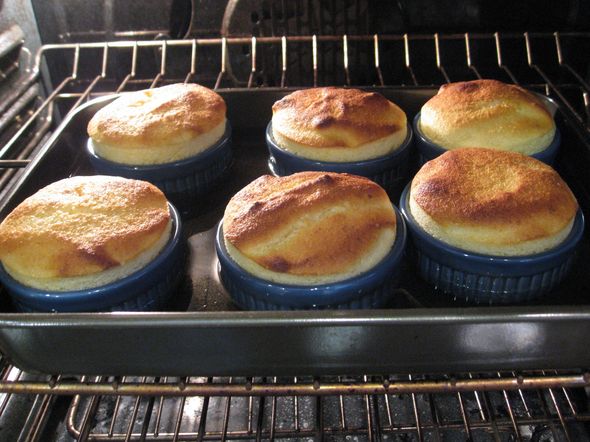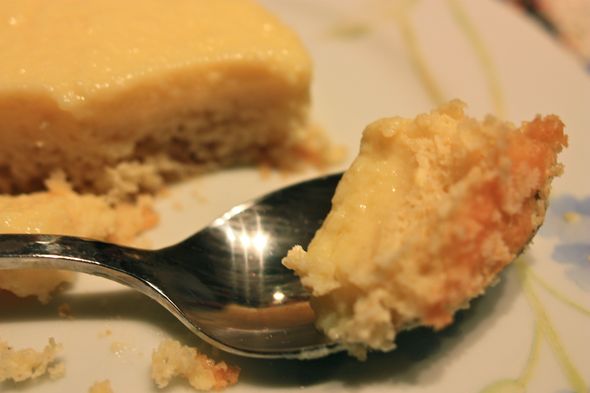Accomplishing the impossible: Lemon Buttermilk Puddingcake (with duck eggs)

A duck egg and two chicken eggs.
Kim Bayer | Contributor
Oh Harold McGee, you maven of food science lore, how is it that your seminal tome On Food and Cooking discusses eggs from page 68 to page 117 but never once mentions eggs other than chicken? I just assumed you'd answer my questions about the properties of duck eggs, but your only words on duck discuss confit and foie gras. Andrew Smith, you're also not much help. The Oxford Companion to American Food and Drink acknowledges the existence of eggs of other chicken with this single line: "Although the eggs of quail, duck and other birds are prized, by far the majority of eggs consumed in America are chicken eggs."
Yes, we like our chicken and eggs here in the States. As of 1999, the US EPA said there were more than 8 billion chickens (yes, "billion" with a b) in the U.S., compared to about 20 million domesticated ducks. According to the USDA, in 2008 American egg operations produced 90 billion eggs, and the annual per capita consumption was around 250 chicken eggs (down from 375 eggs in the 1950s).
By comparison, I'd bet that the per capita consumption of duck eggs is currently a negative number. But, a growing number of farms in our area produce duck eggs, which are often available at the Farmers' Market, and according to the New Agrarian, are wonderful for baking.
Because they have a larger yolk to white proportion, duck eggs have more fat and are richer than chicken eggs. And the chemistry of duck eggs is also a bit different. The whites have more protein, so you need to heat them more gently. But everything you can do with chicken eggs (scramble, souffle, etc.) you can do with an equivalent weight of duck eggs.
After buying some of these large, ivory colored eggs with dark orange yolks from Our Family Farm on the last market day of 2010, and with a New Year's party to host last week, it seemed like the perfect time to bring out one of my favorite recipes: Lemon Buttermilk Puddingcake.

Lemon Buttermilk Puddingcakes in bain marie.
Kim Bayer | Contributor
I loved this dessert so much when I tried their version at the Common Grill in Chelsea, I went out and bought the Common Grill Cookbook. Lemon Buttermilk Puddingcake is my ideal dessert — tart, light, creamy and even a little bit magic.
If you've made a puddingcake before, you know that it's a cake that wants to be a pudding, or a pudding that wants to be a cake. It's one variety of "impossible" desserts that enjoyed popularity in the 1970s. You mix the ingredients in one bowl and, somehow in the oven, they transform into fluffy cake above and creamy custard below, with a delightful purgatory of gooeyness between. 

These lemon puddingcakes are also a perfect seasonal dessert for locavore cooks who believe we deserve some bright citrus here in the wintry north. Except for the lemon (currently in season, and even organic ones are available), all the other ingredients can be had from local sources. And, since you cook the cakes gently in a bain marie, this recipe is also perfect for using your duck eggs.
As for the reasons behind the magical transformation that occurs with "impossible" cakes like these, I'm sorry to say that Harold McGee is silent on the issue of puddingcakes and impossible pies. So much for science. You'll just have to taste it to believe it.
 Lemon buttermilk puddingcakes without the berries are still scrumptious.
Lemon buttermilk puddingcakes without the berries are still scrumptious.
Kim Bayer | Contributor
Lemon Buttermilk Puddingcake with Duck Eggs (inspired by the Common Grill's Buttermilk Lemon Pudding Cake)
1 cup sugar, divided
1/3 cup flour
1/2 cup lemon juice (about 2 lemons, freshly squeezed, can use Meyer lemons)
1/2 cup butter (melted)
3 tablespoon lemon zest (organic)
6 duck egg yolks (see note on separating yolks from whites)
6 duck egg whites
2 cup buttermilk
pinch salt
Thoroughly butter eight eight-ounce ramekins and make sure they fit in the pan you're planning to use for your bain marie.
Blend 1/2 cup sugar with flour and pinch of salt in a mixing bowl. Add lemon juice, zest, melted butter and egg yolks. Mix well. Stir in buttermilk.
In a clean and dry bowl, beat egg whites to soft peaks. Gradually add remaining 1/2 cup sugar, 1 tablespoon at a time, continuing to beat until stiff peaks form. Do not over beat or whites will deflate. Gently fold 1/4 of egg whites into lemon mixture to lighten it. Then fold in remaining whites very gently and completely.
Pour batter into ramekins, 3/4 full. Place ramekins in large pan and pour boiling water 1/2 way up sides. Bake approximately 1 1/2 hours, until top of cakes is light golden. Remove from water bath and cool. Refrigerate at least 2 hours.
To serve, run a knife around the edge of the ramekins and invert onto plate. When inverted it will be soft and creamy on top, and cake-y and fluffy below. Drizzle with blueberry/raspberry syrup.
Blueberry Raspberry Syrup
1 package frozen Locavorious blueberries
1 package frozen Locavorious raspberries
1/2 cup sugar
Simmer all together until berries thicken. Those Locavorious berries are good! Refrigerate until cold. To be extra fancy, put through a sieve to remove seeds. Drizzle on top of puddingcakes. Extra berries are very good on pancakes.
NOTE on separating duck eggs: Duck egg shells are thicker and harder than chicken egg shells. And because the whites are stiffer, the eggs are somewhat more difficult to separate. Remember that you cannot let even a tiny bit of yolk (or any oil) get into the whites if you want them to expand nicely. Follow this method to separate eggs without tears: First, line up 3 small bowls. Separate the first egg. Put yolk in one bowl, white in another. For second and remaining eggs, separate the white into the third empty bowl. Put yolk in with the others. Then transfer the white to the bowl with the other egg whites each time. This way, if you get some yolk in one white, you've only ruined one rather than a whole bowl.
Kim Bayer researches and writes about food and works toward community food security.


Comments
Kim Bayer
Sat, Jan 8, 2011 : 3:11 p.m.
Ed - thanks for the duck egg sources. :) Kim - I'd be interested to know what you think. Duck eggs are supposed to be "tastier" than chicken eggs, but I haven't experienced enough to form an opinion. Roz - the original recipe calls for 9 egg yolks and 4 egg whites. That's another reason I like using duck eggs for this - no leftover whites! Although with leftover whites, you could make a pavlova. :)
Roz
Sat, Jan 8, 2011 : 12:08 p.m.
Sounds like a wonderful recipe. For those of us without duck eggs, what would be the equivalent number of chicken eggs?
Kim Kachadoorian
Fri, Jan 7, 2011 : 3:28 p.m.
Thanks Kim and Ed. Will give duck eggs a try soon.